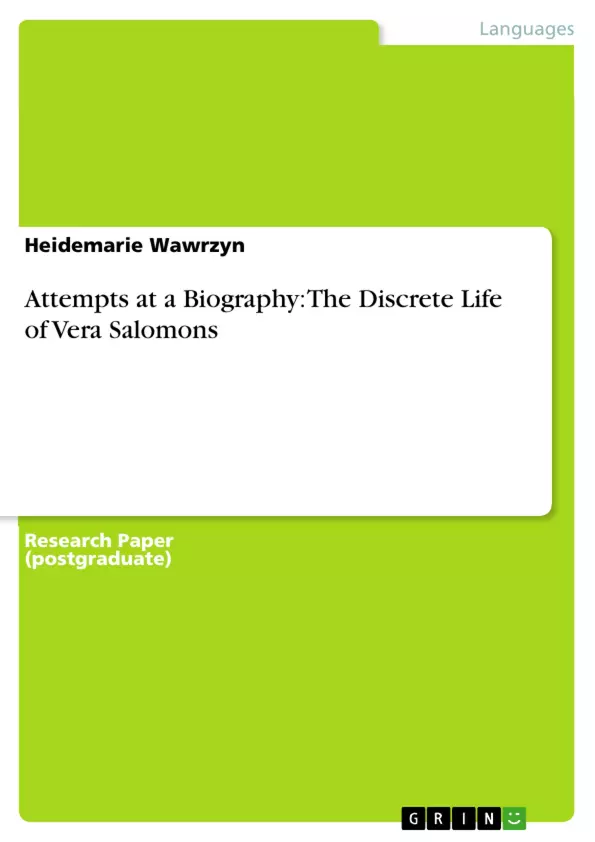During World War I a wealthy British woman, having already published three books, trains as a nurse and while serving in France meets a soldier whom she marries in 1919. After some time she comes to the realization that her marriage is not working. By 1932 she is divorced.
Her name is Vera Frances Bryce Salomons. She was born into a Jewish family in England in 1888, at a time when religious freedom and women’s rights could not be taken for granted. She was a cosmopolitan, a well-versed traveler to destinations such as Italy, Switzerland, France and the British Mandate for Palestine/Israel. In Jerusalem she met Leon A. Mayer, a professor of archaeology and Islamic art. She soon developed a passion for Islamic art. Years later she decided to build a museum in the heart of Jerusalem, the L. A. Mayer Museum for Islamic Art.
Vera Salomons undertook philanthropic work among Arabs and Jews and strove for mutual understanding and tolerance in the region. She was an intensely private, self-effacing woman who left very few documents or photos of herself to posterity. Attempts at a Biography: The Discrete Life of Vera Salomons was written to keep Vera Salomons’ work and mission alive as a source of inspiration for future generations.
Inhaltsverzeichnis (Table of Contents)
- Preface
- Introduction - Jewish Women and Communities in 19th/20th Century Britain
- Vera Salomons' Family
- Great uncle: Sir David Salomons
- Father: David Lionel Salomons
- Mother: Lady Laura Salomons née de Stern
- Siblings
- Vera Salomons' Youth
- From Marriage to Divorce
- A Trip to Palestine
- Philanthropic Work in Palestine
- The Foundation of the L. A. Mayer Museum for Islamic Art
- Vera Salomons' Death
- Collected Memories and Reflections
- Epilog: A Philanthropist's Dream?
Zielsetzung und Themenschwerpunkte (Objectives and Key Themes)
This biography aims to shed light on the life and work of Vera Salomons, a prominent figure in Jewish communities in Britain and a significant philanthropist in Palestine. It seeks to explore her personal journey, her contributions to both the Salomons family legacy and the field of Islamic art, and her commitment to promoting peace and understanding in the region.
- The life and legacy of Vera Salomons
- The influence of the Salomons family on British society
- Vera Salomons' philanthropic endeavors in Palestine
- The founding of the L. A. Mayer Museum for Islamic Art
- Vera Salomons' commitment to peace and understanding in the Middle East
Zusammenfassung der Kapitel (Chapter Summaries)
- Preface: Introduces the author's personal connection to the L. A. Mayer Museum and her motivation for writing the biography, highlighting Vera Salomons' desire for anonymity and the importance of preserving her memory.
- Introduction: Provides historical context by discussing the lives of Jewish women and their communities in 19th and 20th century Britain.
- Vera Salomons' Family: Explores the background of Vera Salomons' family, focusing on her great uncle, Sir David Salomons, her father, David Lionel Salomons, her mother, Lady Laura Salomons née de Stern, and her siblings.
- Vera Salomons' Youth: Delves into Vera Salomons' early life and formative experiences.
- From Marriage to Divorce: Discusses Vera Salomons' marriage and subsequent divorce, offering insights into her personal life.
- A Trip to Palestine: Describes Vera Salomons' visit to Palestine and her initial encounters with the region.
- Philanthropic Work in Palestine: Examines Vera Salomons' significant contributions to Palestinian society through her philanthropic activities.
- The Foundation of the L. A. Mayer Museum for Islamic Art: Chronicles the establishment of the L. A. Mayer Museum, highlighting Vera Salomons' role in its creation.
- Vera Salomons' Death: Reflects on the circumstances surrounding Vera Salomons' passing.
- Collected Memories and Reflections: Presents a collection of personal memories and reflections on Vera Salomons' life and work.
Schlüsselwörter (Keywords)
This biography centers on the life and work of Vera Salomons, focusing on key themes such as Jewish identity, philanthropy, Islamic art, cultural exchange, peacebuilding, and the history of the Salomons family.
- Citation du texte
- Dr. Heidemarie Wawrzyn (Auteur), 2016, Attempts at a Biography: The Discrete Life of Vera Salomons, Munich, GRIN Verlag, https://www.grin.com/document/338671



